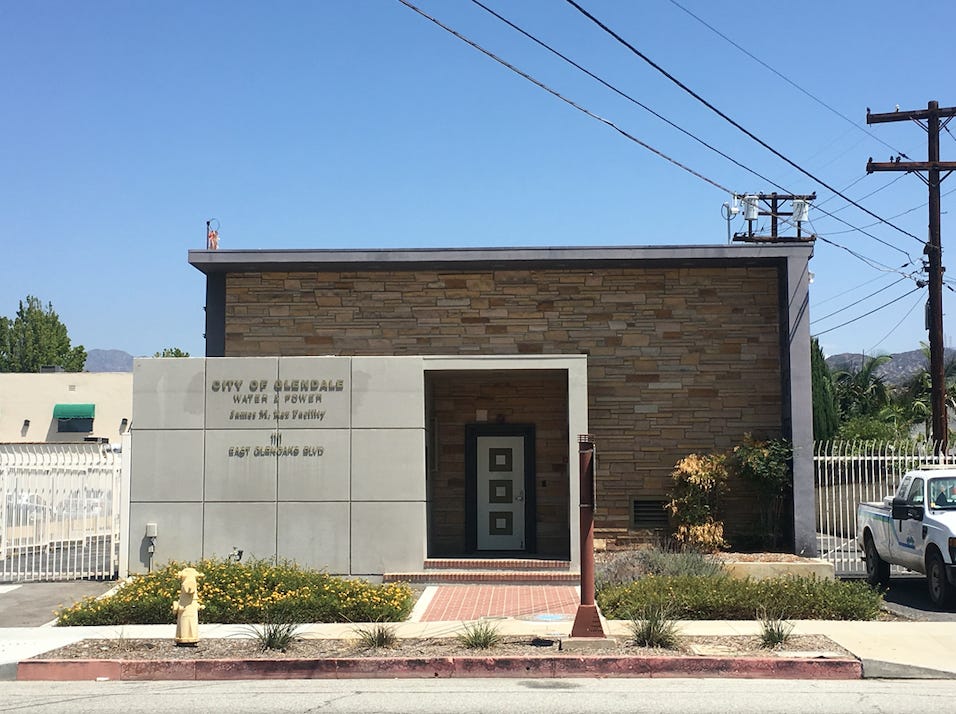Welcome to Glendale, California: a quaint suburb of the major metropolitan center of Los Angeles. Or at least the first closest thing to a suburb you might stumble into while mall hopping, or looking for a drive-thru smoke shop or elegant banquet hall.
Situated on the Rancho San Rafeal, which was given to José Maria Verdugo in 1798, Glendale has always been a quiet town. Nestled at the base of the Verdugo Mountains, its sleepiness is an All-American quality of sunshine and smiles smeared with forgotten white-picket horrors. Of all the populace areas of Los Angeles, Glendale’s history of calm erasure cultivates the feeling of an urban, bustling ghost town.
This newsletter seeks to highlight thematic pockets of its geographical subjects, so I won’t explore too heavily the whole history of Glendale’s being—though in this lens of its vacated haunts, it’s worth noting that Glendale was a sundown town until the mid ‘60s, and also the location of George Lincoln Rockwell’s Nazi headquarters from 1964 to 1967.
Perhaps the phantom limb features of the Jewel City stem from its annexation of Tropico, a smaller city in its shadow until 1917.
In 1887 the name “Tropico” began appearing on Southern Pacific railroad maps. There isn’t a definite origin of the name, but by considering the city of Los Angeles’ boosterism at the time, it was likely pulled out of a marketer’s cap to attract midwesterners to its sunny, fertile climes. In fact the city was known for its strawberries: Tropico Beauties.
The city was known for its agricultural prowess, as well as being the connecting thoroughfare between Glen Dale and what would later become Hollywood and Griffith Park on the Rancho Los Feliz. Its major roadway, Tropico Avenue, would eventually take the name of Los Feliz Boulevard.
To my knowledge, nothing dark or sinister worth marking the history books ever occurred in Tropico (well, I mean, I’m absolutely certain something dark and sinister happened, it was the late 1800s), but it’s worth remembering as it lays the loam for the forgotten histories of Glendale. Tropico had schools and grocers bearing its name, as well as two newspapers, the Tropico Herald and the Tropico Sentinel, the latter of which folded into the Glendale Daily News. Forest Lawn Cemetery claimed Tropico as home in its initial advertisements. At the end of 1917, residents voted to erase Tropico and accept annexation by Glendale. And nearly all traces of its existence were wiped away as well—a fact I find unfortunate as it was such a beautifully mysterious California name. Tropico, Tropico…
According to a pamphlet written by the Friends of Rockhaven, the Crescenta Valley (the area consisting of what is now North Glendale, Verdugo City, and La Crescenta), had the healthiest air quality in all of the United States in the late 1800s. The valley became a concentrated haven of sanitariums for respiratory diseases, with a peppering of facilities for “mild nervous disorders.”
As Tropico became mirage, a nurse named Agnes Richards founded Rockhaven Sanitarium, a facility for women struggling with mental illness, intended to be a serene respite from the horrific state run asylums Richards had been employed by across the country. Decades before we stopped (or did we?) throwing women in harsh, torturous, prison-like clinics for any mental malady, Richards had already witnessed and became appalled by the treatment of women with nervous disorders.
The sanitarium was designed in what is known as the “Cottage Plan” of asylum architecture—small single or double suite dwellings spaced out rather than the traditional hospital or dorm-like buildings; the former more peaceful and tranquil (as well as lending itself to larger expansion opportunities).
While still operating, the facility housed Billie Burke, a wonderful talent of Broadway and silent film, more commonly recognized as Glinda, the Good Witch of the North, as well as Babe Egan, the leader of the 1920s “all girl” band, The Hollywood Redheads, who died at Rockhaven from a stroke in 1966, the same year Marilyn Monroe’s mother stopped attending (who regularly escaped from the grounds).
I would have gathered better images of its current state if the anti-trespassing cameras weren’t blinking at me. Fortunately, a group of concerned citizens, the Friends of Rockhaven, are working to preserve the location and continue to use it as a space for local community, classes, and a proposed historical museum for the greater Crescenta Valley.
The Glendale area grew rapidly in the 70s thanks to the development of the 2 and 134 freeways. Along the southern shadow of the 134, for no particular reason, occurred the sinister one-off crimes that terrorized Glendale.
During the winter of 1977, cousins Angelo Buono Jr. and Kenneth Bianchi, who ran an upholstery shop on Colorado Boulevard in Glendale, murdered 10 women and disposed of their bodies on nearby hillsides, thus garnering the name The Hillside Strangler(s). After abducting the women in various locations across the city, they would take them to their upholstery shop to torture, rape, and eventually murder them (and not just by strangling—the cousins began experimenting with different modes of murder, including electroshock and lethal injection). The shop is now Unik Transmission and is currently in operation.
A few miles across the city, on Stanley Avenue in the literal shadow of the 134 (close to the Glendale In-N-Out), Richard Ramirez, aka The Nightstalker, killed Max and Lela Kneiding, an elderly couple who were avid Dodgers fans and longtime Glendale residents.
The 134 is so close that Ramirez must have been back on the freeway and miles away before the first black and whites arrived at the scene.
A little bit further out, past the Harvard Terrace apartments where Jorjik Avanesian murdered his wife and six children by arson, but still beneath the tall columns of the 134, sits The Derby House. While not a site of a crime, it’s memorable because it was designed by Lloyd Wright, Frank Lloyd Wright’s son, the same architect and in a similar style of The Sowden House on Franklin Avenue in Los Feliz, the supposed site of the murder of Elizabeth Short, aka The Black Dahlia, and the site of many George Hill Hodel organized gatherings with Fred Sexton, Man Ray, and John Huston (all lovers of women-bifurcating surrealism and the writings of the Marquis de Sade).
Glendale has many more ghost stories, and in a few issues we’ll explore its ‘outskirts’, including Miradero, Grand Central Air Terminal, and a few lesser known gems. As much as I don’t want this “city guide” to be directed by culinary pursuits, as seemingly so many explorations of city are, I will end each issue with one recommendation (and one DWP building from the area, my personal pointless pursuit.)
If you’re in the area, have a drink at Dave’s, one of the few LA bars that serve free hotdogs. However, if you’re ACAB, stay vigilant—it’s right by the Glendale police department and is often a cop hang.
Have a nice day!
Your weekly dose of DWP:















here for the free hot dogs
Dig, homie!